In October 2025, Indian equity markets demonstrated
remarkable resilience and strength, with both the Sensex
and Nifty registering strong monthly gains despite
closing the month on a slightly weaker note. The
market’s trajectory was defined by alternating phases of
optimism and caution—early enthusiasm fuelled by
robust corporate earnings and sustained foreign inflows
drove benchmarks to record highs, but profit-booking
and global headwinds toward the month’s end triggered a
mild pullback. This dual-phase performance captured the
complex balance between domestic growth optimism
and external vulnerabilities as investors navigated an
environment shaped by earnings momentum, regulatory
changes,
and
volatile
international
By October 31, 2025, the Sensex settled at 83,938.71,
down 0.55% for the day, while the Nifty closed at
25,722.10, slipping 0.60%. Despite these end-of-month
declines, both indices recorded impressive monthly
advances of nearly 5%—their best performance since
March 2025. The rally was largely fuelled by strong Q2
FY26 earnings and steady foreign portfolio inflows,
particularly into technology, public sector banking, and
telecom stocks such as Bharti Airtel, which touched
record highs during the period. Midcap and small-cap
segments also participated enthusiastically, signalling
broad-based investor confidence. However, the market’s
upward momentum moderated in the final week as
investors opted to lock in profits after sustained gains.
Banking and financial stocks came under notable
pressure following regulatory changes announced by
SEBI that affected Bank Nifty derivatives. Major private
lenders like HDFC Bank and ICICI Bank witnessed heavy
profit-taking, contributing to the overall market’s
weakness. Meanwhile, defensive segments such as
healthcare, pharmaceuticals, and metals also faced mild
declines, as investors rotated capital toward cyclical and
growth-oriented sectors during the earlier bullish stretch.
The Sensex and Nifty’s performance throughout the
month followed a clear pattern—strong early gains driven
by robust buying in IT and banking counters, followed by
a corrective phase triggered by global caution and
sectoral profit-booking. Despite the late weakness, PSU
banks and oil & gas companies provided crucial support,
helping markets sustain their monthly gains.
Global developments exerted significant influence on
market sentiment. Mixed signals from the U.S. Federal
Reserve, especially regarding the timing of potential rate
cuts, weighed on investor confidence. The Fed’s cautious
stance and a stronger U.S. dollar led to intermittent
foreign outflows, slightly dampening risk appetite.
Inflationary pressures in the U.S. and Europe prompted
further tightening by the Federal Reserve and European
Central Bank, temporarily unsettling global equity flows.
Weak global demand also persisted, particularly
affecting India’s export
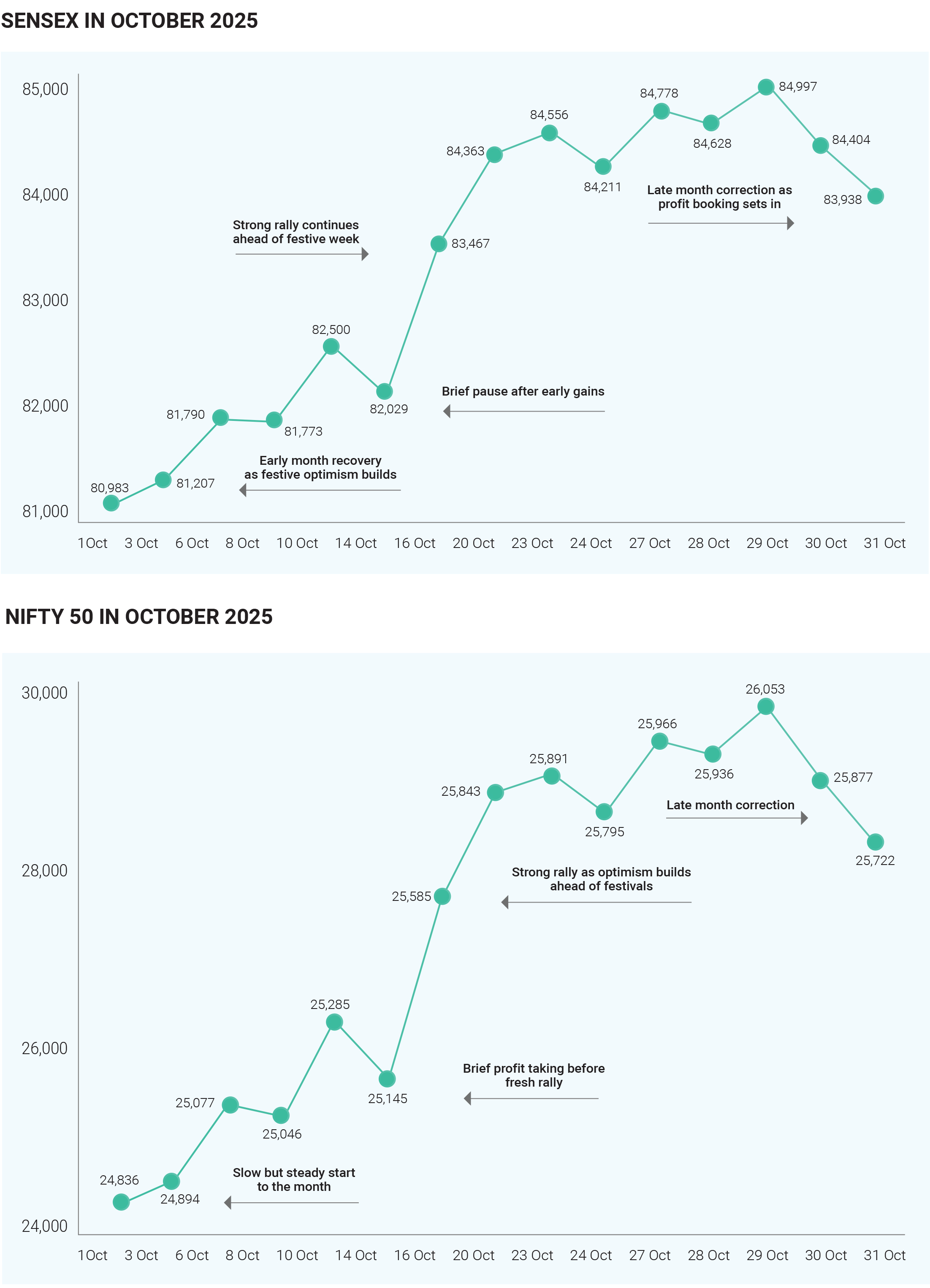
oriented sectors such as IT, pharmaceuticals, and
textiles.
These
challenges
underscored
the
interconnected nature of Indian equities with global
macroeconomic dynamics, even as domestic
fundamentals remained robust.
On the domestic front, the Q2 earnings season played a
pivotal role in shaping market behaviour. Stellar results
from large-cap companies such as Tata Consultancy
Services (TCS) and strong operational updates from
several blue-chip firms boosted sentiment in the early
part of the month. The primary market also witnessed
heightened activity, with major IPOs like Tata Capital and
Groww attracting overwhelming investor participation.
These new listings diverted liquidity temporarily but
underscored the deepening retail and institutional
engagement in Indian equities. The influx of new capital
through IPOs and mutual fund inflows highlighted
investors’ growing confidence in India’s structural growth
story.
However, by the final week of October, the market’s
four-week winning streak came to an end as heavy
profit-booking set in. Small-cap stocks, however,
continued to outperform, reflecting investor appetite for
higher-risk, high-reward opportunities. Public sector
undertakings (PSUs), particularly in banking and energy,
emerged as notable outperformers, offering relative
stability amid the broader correction. Conversely, IT and
private banking counters, which had driven much of the
earlier rally, bore the brunt of the sell-off as valuations
turned rich and traders sought to lock in gains.
The interplay of these forces created a turbulent yet
opportunity-rich environment throughout the month.
Sector rotation was a key theme, with investors
dynamically shifting exposure between cyclical,
defensive, and value-oriented plays in response to
earnings updates, policy changes, and global signals.
Among the primary reasons for the late-month correction
were profit-booking after a sustained rally and uneven
performance across key corporate earnings. Regulatory
announcements, including SEBI’s circular affecting large
private banks’ eligibility norms for derivatives, added to
banking sector uncertainty. Meanwhile, global central
banks’ cautious tone and the continued strength of the
U.S. dollar further deterred aggressive risk-taking by
foreign investors.
Despite these headwinds, the broader narrative remained
optimistic. The resilience of PSU banks and strength in
oil & gas counters reflected selective investor confidence
in value sectors. The buoyant IPO market and steady
mutual fund inflows pointed to deepening domestic
participation. Both foreign and domestic investors
played vital roles in sustaining the market’s strength.
After several months of outflows, Foreign Institutional
Investors (FIIs) returned as net buyers, while Domestic
Institutional Investors (DIIs) maintained consistent
support through steady inflows. This combined
participation helped markets absorb volatility effectively.
FIIs, who had been net sellers from July to September,
reversed course in mid-October, recording their first
positive monthly inflow since June 2025. They
collectively purchased around ₹10,040 crore during the
month, signalling renewed confidence in India’s
macroeconomic prospects. The standout moment came
on October 28, when FIIs logged their largest single-day
purchase—over ₹10,300 crore—marking a decisive shift
from the selling trend of previous months. DIIs remained
steadfast, adding approximately ₹9,537 crore in net
inflows by month-end. Their steady buying offset early
volatility from FIIs and provided a stabilizing cushion
during periods of profit-taking. FIIs particularly increased
exposure to state-run banks, aligning with the PSU
banking rally, while DIIs favoured financials and
consumer-oriented sectors. The revival in FII sentiment
was primarily driven by expectations of a potential U.S.
Federal Reserve rate cut, moderation in the U.S. dollar,
and resilient domestic earnings. Meanwhile, DIIs
continued to deploy funds through systematic
investment plans (SIPs) and tactical sectoral allocations.
Together, these trends underscored renewed global and
domestic confidence in Indian equities.
In conclusion, October 2025 epitomized the dual nature
of India’s stock markets—buoyed by strong domestic
fundamentals
and
corporate
performance
yet
periodically tested by global uncertainties and regulatory
developments. Despite short-term volatility, both the
Sensex and Nifty posted commendable monthly gains of
about 5%, reaffirming India’s standing as one of the most
resilient and attractive investment destinations amid
global turbulence. While short-term consolidation may
persist, the medium-term outlook for equities remains
positive, underpinned by steady economic growth, robust
earnings momentum, and expanding retail investor
participation.
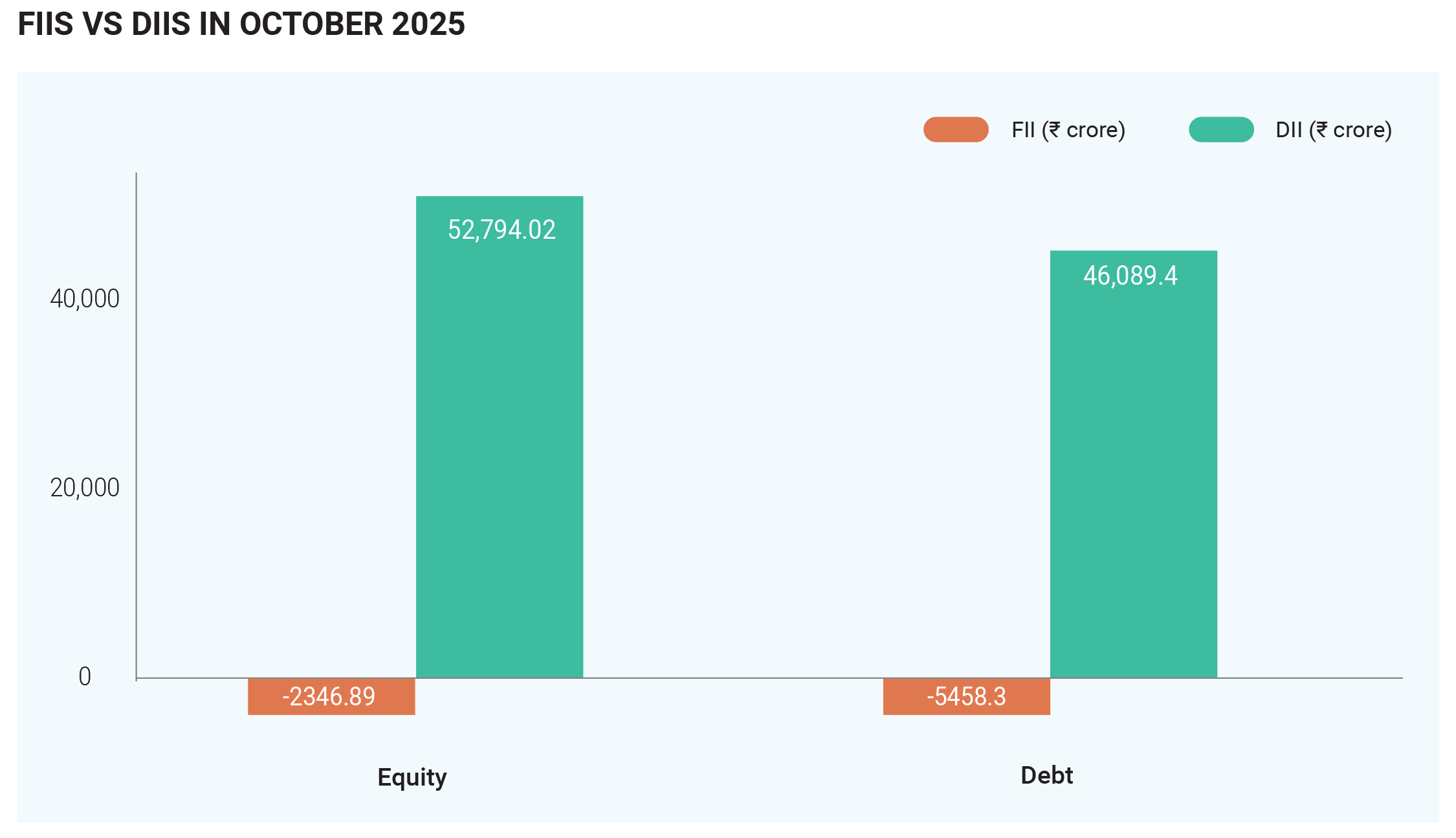
In October 2025, India’s debt market demonstrated
resilience and underlying strength, showing stability to
mild positivity across most segments. While government
bond yields edged slightly higher, the broader sentiment
remained constructive, supported by expectations of a
forthcoming rate-cut cycle and strong demand for
corporate debt. The month reflected a delicate balance
between global uncertainty and domestic optimism, as
both institutional investors and corporates responded to
improving liquidity conditions and policy clarity.
The 10-year benchmark government bond yield rose
modestly by about 6 basis points to close at 6.59% at the
end of October, marking a slight month-on-month uptick
but remaining well below levels seen a year earlier. This
marginal rise was largely in line with global trends, where
U.S. Treasury yields also adjusted amid evolving
expectations of monetary easing in major economies.
Despite the upward movement, investor appetite for
government securities stayed intact, aided by stable
inflation data and signs of fiscal prudence from the
Indian government.
Corporate bond activity, meanwhile, rebounded sharply
after a subdued July–September quarter. October
witnessed fresh issuances exceeding ₹1 trillion,
highlighting renewed confidence in the credit markets.
The resurgence was anchored by large-scale offerings, such
as Bharti Telecom’s ₹105 billion and the State Bank of India’s
₹75 billion bond sales, both of which saw strong investor
participation. Market optimism surrounding an eventual
Reserve Bank of India (RBI) rate cut and a benign inflation
outlook spurred this revival, encouraging issuers to lock in
funds at relatively favourable rates.
Money market instruments and short-duration debt funds
also performed steadily during the month. Continued
liquidity support from the RBI and limited concerns over
inflation or fiscal slippage kept yields on short-term
instruments contained. The overnight call money rate and
commercial paper yields moved in a narrow band, reflecting
healthy systemic liquidity and balanced demand-supply
conditions.
A key highlight of October was the renewed interest from
foreign investors. Foreign Portfolio Investors (FPIs)
registered net inflows exceeding ₹15,000 crore into Indian
debt under the Fully Accessible Route (FAR)—a sharp
contrast to the muted participation observed earlier in the
year. With global growth slowing and major central banks
expected to pivot toward easing in 2026, India’s relatively
high-yielding bonds became increasingly attractive to
overseas investors seeking stable returns in emerging
markets.
The moderate uptick in government yields was
influenced by global cues, as economic data from the
U.S. and Europe signalled weakening momentum, raising
the likelihood of synchronized global rate cuts in the near
term. Domestically, the Reserve Bank of India maintained
the repo rate at 5.5% during its October policy meeting
but struck a notably dovish tone, acknowledging
softening inflation and hinting at a supportive monetary
stance going forward. This policy communication
provided a strong tailwind for corporate bond markets,
fuelling optimism about a lower cost of borrowing in the
coming quarters.
Additionally, fiscal developments contributed positively
to market sentiment. The government’s commitment to
fiscal discipline, including rationalized GST rates and a
lower-than-expected borrowing program for the second
half of FY26, reassured investors about manageable
deficit levels. Inflation remained within the RBI’s comfort
zone, and the absence of major supply-side shocks
further strengthened the case for potential monetary
easing.
Overall, October 2025 was a constructive month for
India’s fixed-income landscape. Government bond yields
saw only a mild increase, while corporate debt markets
experienced robust revival, underscored by strong
issuance volumes and renewed investor appetite. Steady
liquidity conditions, restrained inflation, and positive
policy signals combined to foster a favourable
environment for both issuers and investors. With growing
foreign
participation and
improving
domestic
confidence, the outlook for India’s debt market remains
optimistic, positioning it as a key beneficiary of the
anticipated global shift toward lower interest rates in the
months ahead.
In October 2025, the Indian Rupee (INR) remained largely
stable but exhibited a slight weakening trend against the
U.S. Dollar amid mixed global and domestic developments.
Throughout the month, the rupee traded in a narrow range
between 87.74 and 88.86 per U.S. dollar, reflecting resilience
despite global dollar strength and fluctuating capital flows.
The currency ended the month near 88.72 per dollar, marking
a modest depreciation of about 0.10% compared to
September. This marginal decline underscored the rupee’s
relative stability even as emerging market currencies broadly
weakened under a strong dollar environment.
During the month, the highest exchange rate was recorded
around ₹88.87 per U.S. dollar on October 9, indicating
moments of pressure linked to global risk aversion and
foreign portfolio outflows. Conversely, the rupee touched its
monthly low near ₹87.74 on October 22–23, when a brief
bout of strength emerged following Reserve Bank of India
(RBI) intervention and a pullback in global crude prices.
Despite minor intraday and weekly fluctuations, the currency
remained within a tight range, demonstrating that active
market management and strong fundamentals helped
contain volatility.
The rupee’s movement was influenced by a mix of domestic
and international factors. Globally, the U.S. Federal Reserve
maintained a cautious stance on interest rate cuts, signalling
patience despite signs of slowing economic growth. This
policy approach kept the dollar relatively firm, reducing the
appeal of emerging market currencies. Additionally, lingering
trade deficit concerns and uneven foreign capital flows
exerted intermittent pressure on the rupee.
A major event that shaped currency dynamics was the RBI’s
active intervention in the forex market. On October 15, the
central bank sold U.S. dollars aggressively to curb
speculative demand, leading to the rupee’s sharpest
single-day gain—about 0.8%—in nearly four months. This
move highlighted the RBI’s commitment to managing
volatility rather than defending any fixed level. Such timely
interventions reassured market participants and prevented
excessive depreciation pressures. India’s macroeconomic
fundamentals also provided a strong buffer. With GDP
growth of 7.8% in Q1 FY26, inflation remaining within the
central bank’s comfort range, and foreign exchange reserves
exceeding $700 billion, India’s economic position remained
sound. The current account deficit, contained at around 1%
of GDP, further supported currency stability. These factors
collectively enhanced investor confidence and limited
speculative pressures on the rupee.
In summary, October 2025 was a month of cautious stability
for the Indian rupee. The currency’s slight depreciation
reflected external pressures from a firm U.S. dollar and
global uncertainty, but strong domestic fundamentals,
proactive RBI interventions, and a contained current account
deficit helped prevent any significant weakness. With
resilient macroeconomic indicators and ongoing policy
initiatives, the rupee remained fundamentally stable and
well-positioned to withstand global volatility heading into the
final quarter of 2025.
Crude oil prices in October 2025 experienced persistent
downward pressure, marking the third consecutive
month of decline. Prices fell by about 2.2% during the
month, sliding from approximately $65.36 per barrel at
the beginning of October to around $63.90 per barrel by
month-end, with the lowest point recorded mid-month
near $61.02 per barrel. The month’s movement reflected
a confluence of bearish supply-demand fundamentals,
rising inventories, a strong US dollar, and muted demand
growth across key global economies. Despite
intermittent geopolitical tensions offering temporary
support, the broader sentiment in the oil market
remained cautious and tilted to the downside.
In the first week of October (October 1–7), crude prices
began around $65.36 and weakened slightly as the
market anticipated a significant OPEC+ production hike
of around 500,000 barrels per day starting in November.
Expectations of this additional supply, coupled with
softer refinery demand and the onset of seasonal
consumption decline, outweighed geopolitical concerns
that might have otherwise supported prices. Traders also
factored in the likelihood of continued output growth
from non-OPEC producers, setting a subdued tone early
in the month. During the second week (October 8–14),
Brent crude briefly approached a mid-month high near
$66.40 on October 8 before retreating amid choppy and
bearish trading conditions. A key catalyst for the decline
was the unexpected surge in US crude inventories, which
signalled that supply continued to outpace demand. The
build-up in inventories raised concerns about a potential
supply glut, dampening market optimism. Even as
geopolitical risks persisted in parts of Eastern Europe
and the Middle East, they failed to generate sustained
price gains, as investors focused on the broader
oversupply narrative and weaker refining margins. The
third week (October 15–21) saw the steepest drop of the
month, with crude prices tumbling to a low of around
$61.02 per barrel on October 20. This phase was
characterized by pronounced bearish momentum driven
by abundant supply and limited demand growth. OPEC+
production remained high, while US shale producers
continued to expand output. Meanwhile, large stockpiles
both onshore and in floating storage underscored market
oversaturation. Demand uncertainty from major
consumers, particularly China—where industrial activity
showed signs of slowing—further weighed on sentiment.
The combination of rising output, soft consumption, and
excess inventories created a decisive downward turn in
prices. In the final week of October (October 22–31),
crude oil prices showed signs of stabilizing but remained
subdued. Market participants reacted to reports of fresh
US sanctions on Russian oil companies and regional
geopolitical tensions, but these factors offered only
fleeting price support. A robust US dollar added to the
downward pressure, as it made oil more expensive for
holders of other currencies, curbing international
demand. OPEC+ confirmed another output increase
planned for December but indicated a pause in
production hikes for early 2026, providing mild
reassurance to traders that the supply surge might soon
moderate.
Overall, October 2025’s oil market was defined by the
interplay of rising global supply, weakening demand, and
macroeconomic headwinds. Production from both
OPEC+ and non-OPEC nations continued to rise, creating
an oversupplied market environment. Demand growth
slowed, particularly in OECD countries and China, as
global energy transitions and efficiency measures
curtailed consumption. The strengthening of the US
dollar compounded price pressures, while rising
inventories across the US and other regions signalled
slackening demand momentum. Although geopolitical
uncertainties—such as tensions involving Russia and
Iran—offered temporary support, they were insufficient to
offset
the prevailing
bearish
fundamentals.
Consequently, October closed as another challenging
month for crude benchmarks, reinforcing the perception
of a well-supplied market grappling with a fragile demand
recovery and a stronger dollar backdrop.
In October 2025, gold and silver prices in India reflected a
dynamic mix of festive enthusiasm, currency
movements, and global precious metal trends. Both
metals witnessed strong mid-month rallies fuelled by
domestic demand and safe-haven buying before easing
slightly toward the end of the month. The festive period
surrounding Diwali, a key driver of India’s gold and silver
consumption, coincided with global uncertainties and a
softer rupee, creating the perfect setup for a price surge
in both commodities.
Gold began October on a steady note around ₹11,900 per
gram but soon gathered upward momentum as robust
jewellery demand emerged ahead of the festive season.
The rupee’s mild depreciation further added to the local
price rise, as it made imported bullion more expensive.
By mid-October 24-carat gold touched an all-time high of
approximately ₹13,277 per gram, mirroring the global
rally that saw international prices breach the $4,000 per
ounce mark. The surge was underpinned not only by
Indian festive buying but also by sustained central bank
accumulation worldwide, as policymakers sought to
diversify reserves amid economic and geopolitical
uncertainties. However, the rally lost some steam in the
second half of the month. As the festive fever cooled and
global bullion prices corrected modestly, Indian traders
engaged in profit booking. By the end of October, gold
had stabilized around ₹12,200 per gram—still
significantly higher than its early-month level, signalling
resilient underlying demand. Overall, the month
reaffirmed the strong seasonal influence of Indian
consumers on gold prices and highlighted how global
and domestic factors often converge to shape
short-term trends in bullion markets.
Silver followed a similar trajectory but with even sharper
swings. The metal started the month trading near
₹1,51,000 per kg and experienced a steep surge through
the first half of October. Around October 13, silver
climbed to about ₹1,85,000 per kg, and within just two
days, it spiked further to nearly ₹1,90,000 per kg, marking
one of the sharpest short-term gains in recent months.
This rally was driven by festive-season demand,
heightened investment interest, and a weaker rupee,
which inflated import costs. Silver’s dual role as both an
industrial and investment metal also attracted buyers
seeking diversification and inflation protection amid
global market volatility. Toward the month’s end, some
cooling occurred as traders booked profits and retail
buying normalized. Even so, silver remained well above
its early October levels, underscoring sustained investor
confidence and festive-led demand momentum that kept
the metal shining bright through October 2025.
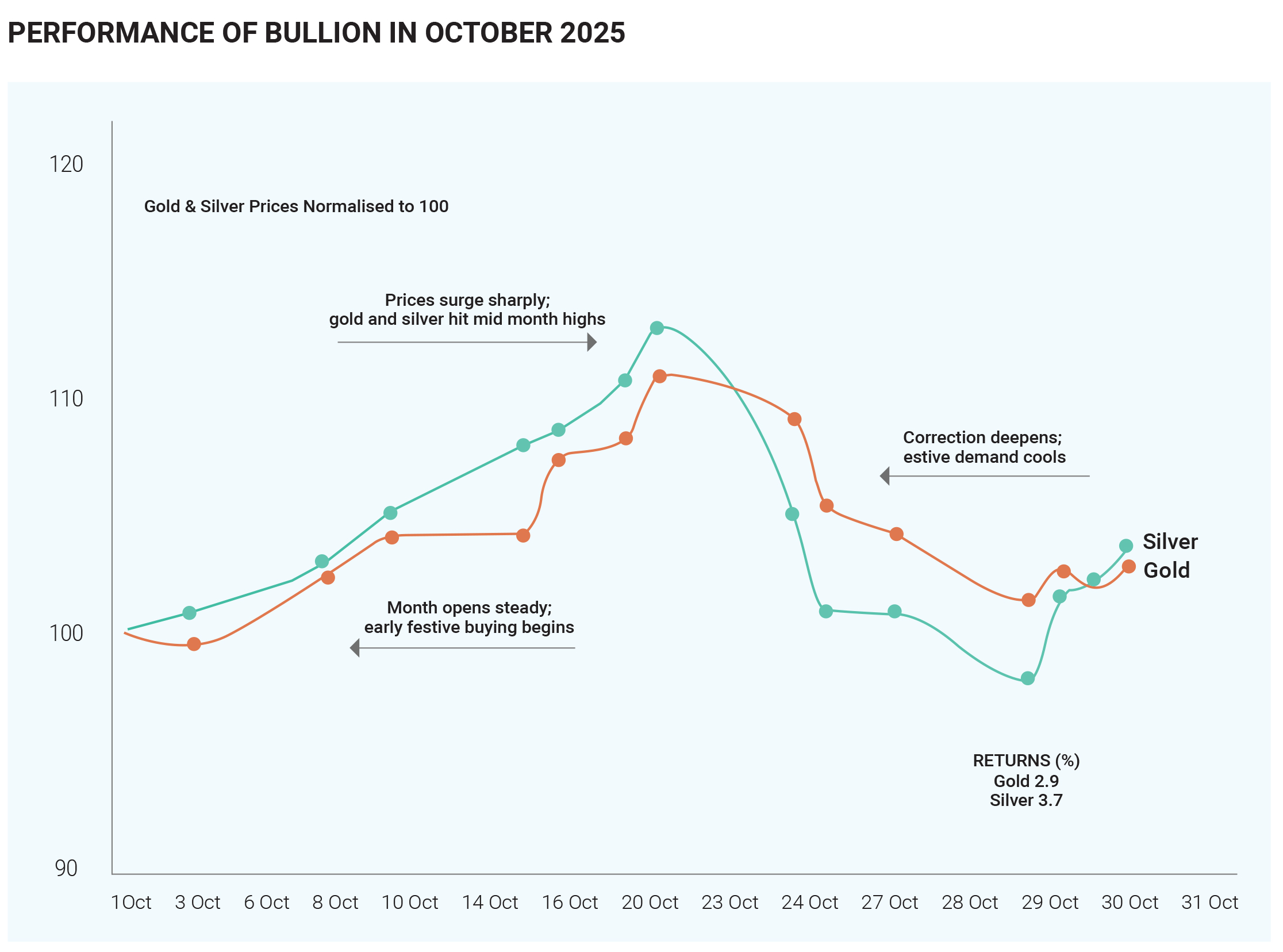
October 2025 was a dynamic month for the Indian
mutual fund industry, marked by strong equity inflows,
steady growth in hybrid schemes, and cautious
sentiment toward debt funds. Despite global
uncertainties and volatile market cues, investors
displayed sustained confidence in domestic equities,
driven by robust corporate earnings and resilient market
performance. The overall industry maintained a healthy
growth
trajectory,
underscoring
the
deepening
penetration of mutual funds across investor categories
and geographies.
Equity mutual funds were the standout performers in
October, attracting net inflows of around ₹14,610 crore.
This surge reflected rising investor optimism as the Nifty
index advanced by 4.51% during the month, supported by
solid quarterly results and strong institutional buying.
Sectoral and thematic funds saw particularly impressive
traction, led by themes such as technology, electric
vehicles, and artificial intelligence. Large-cap funds,
meanwhile, provided stable long-term performance, with
top performers such as Nippon India Large Cap Fund
posting 8.4% annual and over 26% five-year returns,
highlighting their consistency and defensive strength.
The overall trend in equity fund flows indicated sustained
retail participation, buoyed by rising SIP (Systematic
Investment Plan) contributions and growing investor
trust in long-term wealth creation through equities.
Debt mutual funds, on the other hand, experienced net
outflows of approximately ₹20,987 crore in October.
Investors
adopted a cautious stance toward
fixed-income assets amid flat bond yields around 6.5%
and lingering concerns about potential interest rate
volatility. The lack of meaningful movement in yields,
combined with quarter-end portfolio adjustments, led to
redemptions across several short-duration and liquid
fund categories. Although fixed-income AUM expanded
over the year due to base effects, the near-term
sentiment remained subdued as investors preferred
equity and hybrid exposure in anticipation of better
returns.
Hybrid funds emerged as a key beneficiary of market
uncertainty, registering healthy inflows of around
₹20,987 crore. Investors continued to favour aggressive
and
balanced hybrid schemes, which offered
diversification benefits by combining equity upside
potential with the relative stability of debt. The growing
popularity of these funds reflected a preference for
moderated risk amid volatile equity conditions.
At the industry level, assets under management (AUM)
reached a record ₹75.61 lakh crore by September 2025,
up 12.7% year-on-year. Monthly SIP inflows touched
₹29,361 crore, marking a 20% rise from the previous year
and signalling deepening investor participation. Equity
funds accounted for about 61% of total AUM, while
passive
funds—including
index
funds
and
ETFs—expanded their share to 17%, driven by cost
efficiency and rising investor awareness. Notably,
smaller asset management companies outside the top
15 continued to gain market share, suggesting a more
competitive and inclusive fund landscape.
In summary, October 2025 underscored the resilience
and maturity of India’s mutual fund industry. Equity and
hybrid funds thrived on strong market momentum, SIP
growth, and investor optimism, while debt funds faced
redemptions amid stagnant yields. The overall picture
reflected a sector in transition—balancing growth with
prudence—as investors diversified across active,
passive, and hybrid strategies to navigate evolving
market conditions.
In October 2025, India’s insurance sector exhibited
strong growth and structural transformation across life,
health, and general insurance segments, supported by
rising consumer awareness, digital innovation, and
economic expansion. The life insurance segment
continued its positive trajectory, recording a 5.1%
year-on-year rise in New Business Premiums (NBP) for
FY 2025, reaching ₹3.97 lakh crore. Individual NBP
increased by 11% to ₹1.74 lakh crore, driven by robust
new agent recruitment—over 11 lakh additions—and
accelerated digitization across distribution channels.
While private insurers led this growth with new product
offerings and improved customer engagement, the Life
Insurance Corporation (LIC) experienced marginal
declines in certain key categories due to ongoing
product realignments and regulatory adjustments in
commissions and surrender values.
In the non-life segment, health and motor insurance were
major growth drivers. Private players like ICICI Lombard
reported an 18% year-on-year profit increase in Q2 FY25,
fuelled by a 50% surge in retail health premiums and a
10% uptick in motor insurance after tax reductions in the
auto sector. Rising healthcare costs and post-pandemic
awareness continued to boost health insurance
demand. However, public sector general insurers faced
weaker underwriting performance and solvency
constraints, while private firms expanded aggressively
with strong capital positions.
Looking ahead, India’s insurance industry is projected to
grow to ₹19.3 lakh crore (US$222 billion) by FY26,
supported by digital reforms, AI-driven automation, and
broader rural outreach through platforms like IRDAI’s
“Bima Sugam.” Emerging trends such as IoT-based
insurance—expected to grow at 55% CAGR to ₹1.83 lakh
crore
by
2033—underscore the sector’s rapid
technological evolution.
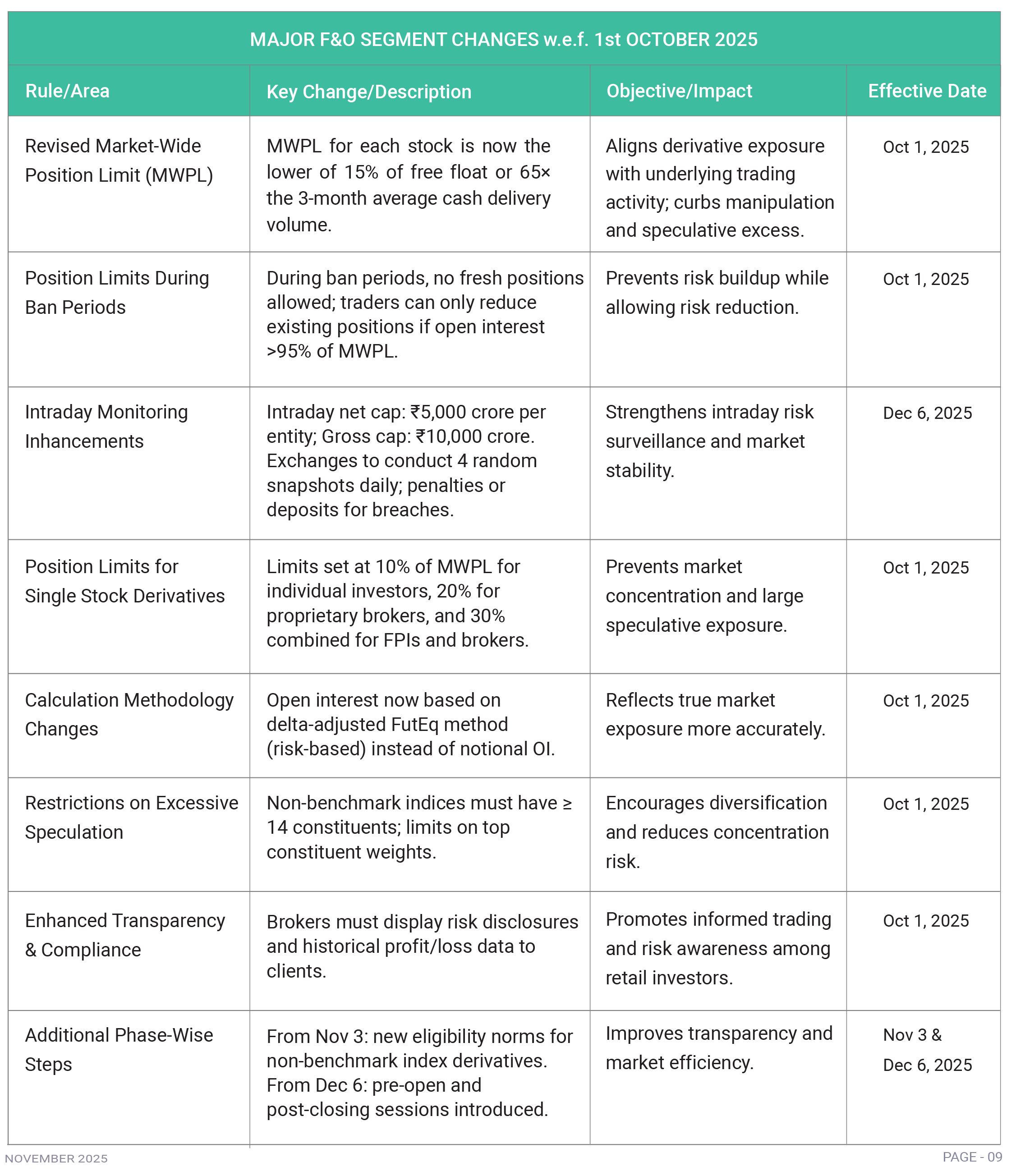
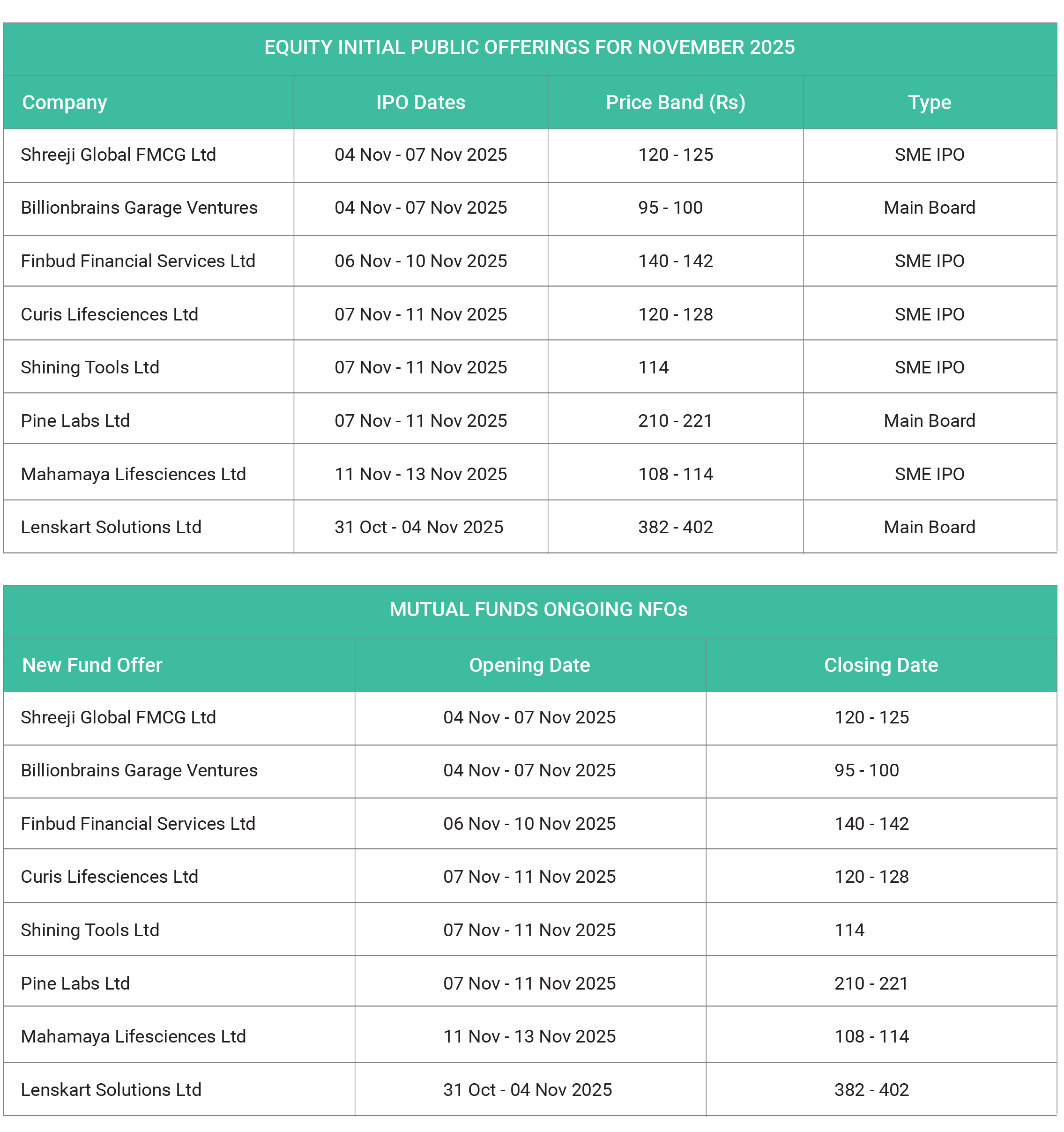

Copyright © 2021 Fintso
